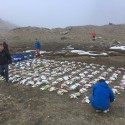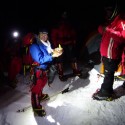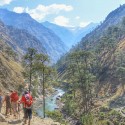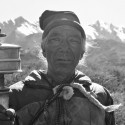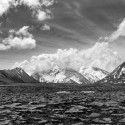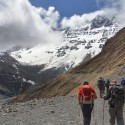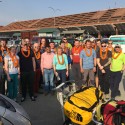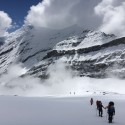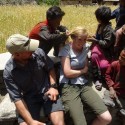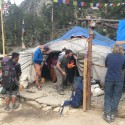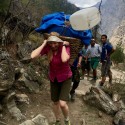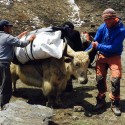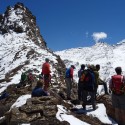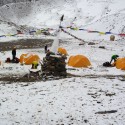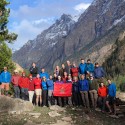Ex AMA 60 was a Pan Army, Army Mountaineering Association (AMA), High Risk and Remote, mountaineering & trekking expedition to the remote Dolpa region of Western Nepal. It was open to all AMA members, and the team consisted of both Regulars and Reserves. It was conceived to celebrate 60 years of the formation of the AMA and was in two parts. A 12 person trekking team set out on the very remote Lower Dolpa circuit from Dunai to Jomson and a 12 person climbing team attempted the little climbed Putha Hiunchuli (7320m). Putha Hiunchuli was first climbed by an early AMA member (JOM Roberts – the father of commercial trekking in Nepal) in 1954. The peak was also chosen because of its extreme height with non-technical terrain, offering the best chance of summit success.
Captain Hugill YORKS sets the scene:
30 minutes after taking off from a remote airport near the Indian border, the plane violently banked a steep left. Below us we could see aircraft parts, strewn all over the magnificent mountainside just before the runway appeared. A safe landing was far from guaranteed. The output from the body’s natural reaction to a severe case of food poisoning was running through the aisle on the cramped 15 seater aircraft. This was not the most comfortable way to start a 13-day trek in the Dolpa Region but it certainly was exhilarating.
Upon landing, we were greeted by crowds of locals from the nearby village. We stood in awe of the snow-topped peaks as porters ran around, collecting our bags and preparing to move from the runway to the town of Juphal. A meal awaited us in a local community centre. I had to wait for my stomach to settle before consuming the first of many portions of dal bhat (rice and lentil soup) that would follow throughout the expedition.
Dolpa is the largest district in Nepal but also one of the less famous areas. We were told that we were the only tourist group that had booked permits to trek in Dolpa through our tour agency in 2017. We were truly in a remote part of the world. During the expedition, we only saw one other western tourist.
Life is simple but tough in the isolated settlements of Nepal. The majority of the local population work the land. Farming crops and managing livestock to survive the harsh weather conditions. Hoping to produce a little bit extra food to sell and exchange for other goods. They have little of the modern “necessities” we have become accustomed to in the west. Even our guide and porters had the most basic equipment. Whenever it rained or snowed, they would use a large plastic bag to protect themselves from nature’s elements. These men were as tough as they come. One of the porters was found to be suffering from trench foot but still carried on with little fuss. Luckily we had two doctors on the team to help him.’
The Trek
Captain Hugill YORKS continues:
Our trek from Juphal to Kagbeni was 158 km long with a total climb 10,848 metres. Our highest point of the expedition was 5200 metres above sea level. All this sounds impressive but in reality, means very little. What was important, was the experiences we gained through the hardship, challenge and teamwork of being part of a close-knit group. The AMA had brought together 12 strangers. Our only common connection being our shared love for the outdoors and that we were all serving members of the British Army, be it Regular or Reserve. The group was a diverse mix of personalities, trades, ages and experience.
Walking through the epic valleys, snow covered peaks and along lush flowing rivers was an experience that will stay with me forever. I have never been to a place as beautiful as Nepal. The scenery and weather can change in an instant. We would often retire for the night with clear skies and dry conditions to then wake up to a blanket of snow around our tent. Regardless of the weather, it was impossible to get bored of the view.
One of the highlights of the expedition was meeting the friendly Nepalese people. Dolpa is heavily influenced and linked to Tibetan culture. Tibetan is widely spoken and the small settlements and religious monuments are very similar to what would be found in Tibet. The people were the kindest and happiest I have ever met. By saying the greeting “Namaste!”, followed by the joining of the palms in an upwards prayer motion, we were always made to feel welcome. Learning just this phrase made a huge difference to how the local people approached us. Never before have I seen people with so little, willing to give so much.
The Climb
Army Reserve Climbing Team member and ex PARA, Cpl Shawn Stock RAMC tells his own personal story:
‘After two weeks of walking, talking and then walking in silence, we sat, read, wrote, waited and watched the people of Kagkot. This was to be the meeting point for our yaks and the point when we parted form the trekking team to go our separate ways. While there I could not help but think that the people had an inherent knowledge that there is something more than what surrounded them. Apart from us and the village lama praying each morning at 0600, with drum and symbol to hand, there wasn’t much else going on.
Time teaches many things, one being acceptance of that which we cannot change
Weather is one of those things and yaks are the other. After a period of snow and rain along with observing the locals observing us, our new militant yak herder friends arrived, strongly resembling bandits. Later we would become familiar with the screams, screeches, whistles, grunts and groans it took to herd these troublesome beasts.
With our western ways of urgency and haste we asked our Sirdar, Tenzing Sherpa, when it would be possible to move over the pass from Kagkot. He explained that after the storms we’d had, the pass was too muddy and full of snow and had to dry out before crossing them. This at the time was unbelievable as a yak is built like a tank.
Tom, one of the climbers, suggested to Tenzing that we should strap crampons onto the yaks’ hooves. That way they’ll be able to make it through the snow and over the pass. This made Tenzing burst out with laughter. A man of his nature smiles to accommodate. But this was genuine and not something he’d do easily. Of course this was a ridiculous idea as we hadn’t any reinforced extension bars for the crampons.
Generosity
There is a prayer which quotes the words “to toil and not to seek for rest, to labour and ask for no reward “. These words derive from Christianity, a far cry from Buddhism or Hinduism. They are almost a memorandum, a reminder of what we should try to emulate.
The Sherpa carries this out continuously, seamlessly without fluctuation and without act! Testimony that actions speak louder than words. His manner and decorum, not to mention stamina are looked upon with high regard and respect.
One particular Sherpa showed me generosity and help on a number of occasions. From sharing food, a rock to sit on and finally carrying a large amount of my kit on descent. Acute Mountain Sickness had taken its toll and so I had to go down with no chance of re-joining the team. The decision was made for me, but at the same time I could not fail to disagree. To be a stumbling block to those around me would be a nightmare and I felt it imperative that the team summit. This train of thought made the extraction less excruciating and more bearable to stomach.
Having your own kit carried for you is a big deal and in exchange holds a lesson for you to carry. It doesn’t expose who you are as a person, the mountain does that. But where you are as a person, and for all to see. To swallow your pride and except the offering is a harder lesson to learn than to carry the weight.’
We all pay, we pay dearly! It’s what we give of ourselves which determines the outcome
By the end of the expedition elements of the 12 person climbing team got within 200m of the 7230m summit of Putha Hiunchuli / Dhaulagiri 7. All 12 members of the trekking team successfully completed the Lower Dolpa circuit.
All team members of both teams gained a rare insight into their own strengths and weaknesses, amplified by the extremes of high altitude, cold, limited sleep, and lack of personal space. Altitude has no respect for fitness or experience, and those that had previously found physical challenges well within their comfort zone suddenly found themselves having to cope with the experience of being pushed to their limits: something that is very character building when you are not used to it.
A huge debt of gratitude goes to the Ulysees Trust, without whose support this 60th anniversary of the mountaineering club that set Sir Chris Bonnington and many others on their climbing careers would not have been possible.

